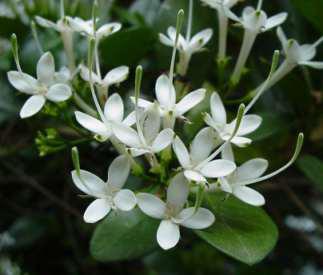Pavetta revoluta
Pavetta revoluta Hochst.
Family: Rubiaceae
Common names: dune bride's bush ( Eng. ); duinebruidsbos (Afr.); umCilikishe (Xhosa); umHlabambaza (Zulu)
SA Tree No: 720
Introduction
This white-flowered shrub or a small tree is a joy to have in the garden; it also attracts wild life to the garden.

Description
Description
Pavetta revoluta is an evergreen shrub up to 6 m high. The bark is smooth in texture and light-coloured. The leaves are simple and oppositely arranged, leathery, oval, 80 x 40 mm, green and glossy above and paler and duller below, with hairy pockets in the axils of the nerves below; the margins are untoothed and rolled inwards.

The flowers are white, in dense clusters of up to 75 mm in diameter, usually at the end of the side branches; the corolla tube is ± about 13 mm long, the style long and protruding, and the calyx has pointed lobes as long as the calyx tube. The fruits are soft and black when ripe. Flowering time: late spring to early summer.

Conservation Status
Status
This tree is not threatened by any means in the wild. According to the Threatened Species Programme it is categorized as Least Concern.
Distribution and habitat
Distribution description
Pavetta revoluta occurs from Port Alfred up through the former Transkei region ( Eastern Cape ) to KwaZulu-Natal in forest and dune bush. It is confined to a narrow strip along the coast, not far from the sea. It grows in a dwarf form on the sea shore.
Derivation of name and historical aspects
History
The genus Pavetta is derived from the Sinhalese name, Pawatta. The specific epithet revoluta is Latin and means rolled back, and refers to the inrolled leaf margins. There are 21 Pavetta species in southern Africa. Pavetta obovata, the name used prior to Bredenkamp's revision of Pavetta in 1934, was published in 1844 as a nomen nudum (new name) by Drège and attributed to E. Meyer. In 1865, Harvey & Sonder provided a description of the species in Flora capensis. Hochstetter, however, had 23 years previously, described the same species as Pavetta revoluta, which name he based on Krauss's species numbers 92 and 195, collected in KwaZulu-Natal. Pavetta revoluta is thus the earliest legitimate name for this plant, and the correct name to use.
Ecology
Ecology
The flowers are pollinated by bees and butterflies. The fruits are eaten by some birds and so the seeds are dispersed.
Uses
Use
This is a lovely shrub with great horticultural potential. It is a good specimen for small gardens and as a specimen plant in a pot. It is reported that the Xhosa people use it for rheumatism and as emetic insecticide.

Growing Pavetta revoluta
Grow
Pavetta revoluta can be grown from seeds or cuttings. Sow seeds in summer in a seed tray in a well-drained, well-aerated soil mix. Treat the seed with an antidamping-off fungicide. Spread the seeds evenly and cover with a layer of fine bark or river sand. Water the seed tray and place it in a warm place. Germination should take place in 3-5 weeks under optimum conditions.
Take semi-hardwood cuttings in spring. Cuttings must be dipped in a rooting hormone to stimulate root development. The growth medium should be a mixture of 50% bark and 50% polystyrene. Treat the tray with a fungicide and put it in the mist unit on a bench with under-heating. Rooting should take six weeks.
References
- Jackson, W.P.U. 1990. Origins and meanings of names of South African plant genera. University of Cape Town Printing Department, Cape Town.
- Leistner, O.A. (ed.). 2000. Seed plants of southern Africa : families and genera. Strelitzia 10. National Botanical Institute, Pretoria.
- Palmer, E. & Pitman, N. 1972. Trees of southern Africa. Balkema, Cape Town.
- Van Wyk, A.E. (Braam) & Van Wyk, P. 1997. Field guide to trees of southern Africa. Struik, Cape Town.
- Vorster, P. 1977. Pavetta revoluta. The Flowering Plants of Africa 44: t. 1750.
Credits
Giles Mbambezeli
Kirstenbosch NBG
December 2007
Plant Attributes:
Plant Type: Tree
SA Distribution: Eastern Cape, KwaZulu-Natal
Soil type:
Flowering season: Early Summer
PH:
Flower colour: White
Aspect: Full Sun, Morning Sun (Semi Shade), Afternoon Sun (Semi Shade)
Gardening skill: Easy
Special Features:
Horticultural zones









Rate this article
Article well written and informative
Rate this plant
Is this an interesting plant?
Login to add your Comment
Back to topNot registered yet? Click here to register.